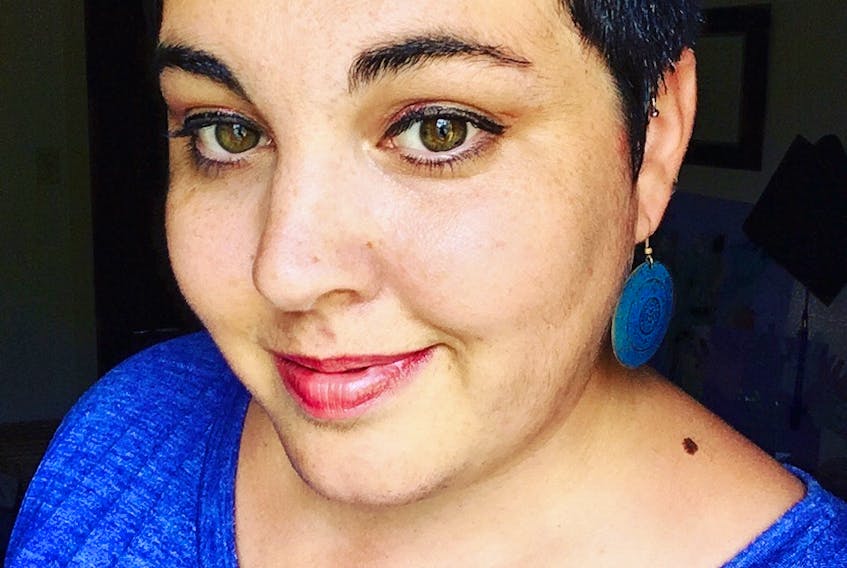WOLFVILLE, N.S. — Laura Fisher says she is one of the lucky ones.
After listening to her story, the average person could disagree.
When her marriage abruptly ended, she became a single mother who was introduced to the eye-opening world of life on social assistance.
“I was lucky, I was dealing with the same situation as many of the others, but I had advantages because of my education and my family background,” she said.
This experience led her on a journey to challenge the misconceptions often associated with the welfare system - about who’s on it, and why.
She co-authored the 2019 Report Card on Child and Family Poverty in Nova Scotia with Acadia researcher Lesley Frank.
“I’m cautious about telling my story because it sometimes gets turned into an example, you know, because I did it anyone can,” she said. “You just pull yourself up by the bootstraps.”
“But it’s not like that, I had advantages that not everyone has. I had educated parents and some education. A lot of people don’t have that.”
Painful stigma
When Fisher’s marriage ended a few years ago, she found herself navigating an unfamiliar social welfare system that many can’t escape. She encountered a maze of bureaucracy, judgement, and lost friendships.
“I’m off it now, but I’m not far from it. People don’t talk about poverty, because the stigma around it is almost more painful than the poverty itself,” she said.
“People are aware people are talking to them differently because of the change in their social situation, and they are being blamed for their situation. When it happened to me, I lost friends. It’s like they thought it was contagious.”
Fisher says that many people are probably living closer to the edge of poverty than they are close to becoming a millionaire. Many are a sudden event away from income assistance, or bankruptcy.
Some suggest that those living on social assistance are lazy and looking for handouts.
Poverty is hard work, Fisher stressed.
People requiring assistance often deal with multiple agencies and need literacy skills, a knowledge of the system, time, and transportation to fill out required paperwork.
The sheer amount of work needed to justify need was exhausting, she said.
Domino effect
Each time she approached an agency — housing, social assistance, food banks, and charities — she was required to share her hardship to a new set of ears and forms.
The work of being poor and hungry also puts people at risk for mental illness, and means they are less resilient in the face of adversity.
“I am a masters’ student and a single mother with three jobs. I slept less and worked harder when I was living on social assistance,” she said.
“It’s not just ‘one more form’ when you are struggling. There is a real domino effect with low income. One thing leads to another.”
Housing is another concern.
As a single mother on social assistance, Fisher found the options were extremely limited when she looked for affordable and appropriate housing.
“People were suspicious because I was on my own. There were a lot of personal questions,” she said.
“They would say, it’s not you we don’t trust, its income assistance. For me, it was luck and timing to find a place. A lot of people are not that lucky. They may end up couch surfing with their kids taken away.”
Lucky breaks
Fisher said part of her lucky streak was encountering kind and inspiring people along the way. The one who saved the pots and pans and helped her at her first apartment. The director at the women’s shelter who encouraged and supported her.
“I enrolled in a work readiness program and knew I wanted to go to school. It’s hard to do that when you are on social assistance,” she said.
“I was doing a research project and found the report. I saw that other people were researching things that were impacting people’s lives, making recommendations that could help. It set me on the path.”
Finding Frank’s annual child poverty report showed her that she was not alone.
Others were facing the same situation and, for Fisher, the way out was through higher education. It seemed more like a pipe dream back then, but she wanted to help herself - and others.
A new trajectory started to reveal itself in her life.
She sought out scholarships and found a way to return to school.
She has worked hard over the past several years, ultimately finding herself co-authoring the same report that inspired her.
Fisher hopes her story will reach someone who needs the inspiration to fill out one more form, try one more time to reach out for the support they need.
After all of this resiliency and work, she still credits most of her success to luck and kindness.
“I’m white and don’t have learning disabilities,” she said.
“I worked hard, I’m smart, but I’m lucky to get scholarships. Even still, I have a high debt load.”
Wolfville researcher continues to push for action to end child poverty
Lesley Frank probably suffers most from déjà vu.
For the past 20 years, she has been compiling data for the annual report card that looks at child poverty rates in Nova Scotia. Every year, governments fail to make good on a historic promise to eradicate child poverty in Canada by the year 2000.
“Thirty years ago, an all-party resolution was passed in the House of Commons to eliminate poverty among Canadian children by the year 2000,” said Frank, an associate professor at Acadia University and research associate for the Canadian Centre for Policy Alternatives.
“The first report card was done 20 years ago. Coming up to the deadline we asked: how are we doing? Things were actually worse in the 1990s.”
The 2019 Report Card on Child and Family Poverty in Nova Scotia, entitled “Three decades lost,” said nearly 25 per cent - or 40,710 - children in the province were living in poverty “based on the most recent data.”
One of the biggest changes over the years, Frank said, has been the availability of data.
In the past, she relied on comprehensive survey information that was collected by Statistics Canada, but many of these detailed surveys were discontinued, leaving her pulling bare bones numbers from census and income tax data that is stripped of personal information.
“Lots of poverty stats are floating around, it’s very confusing for people. The picture painted depends on data source and the indicator used,” Frank said.
She based her latest analysis on 2017 data collected by Statistics Canada.
The 2017 numbers showed Nova Scotia falling behind other provinces.
“By 2017, Nova Scotia has the third-highest provincial child poverty rate in Canada, and the highest rate in Atlantic Canada,” the report, co-authored by Frank and Acadia masters’ student Laura Fisher, reads.
Some progress
Department of Community Services spokesperson Lynette Macleod said the 2018 data released by Statistics Canada in February, after the child poverty report came out, indicates that some progress has been made within the province.
“It shows government’s efforts are yielding positive results and helping the most vulnerable people in our province. In fact, Nova Scotia had the most significant improvement among all provinces as compared to the previous year,” said Macleod via email March 12.
“While we are encouraged by this improvement, we know there is still more work to be done.”
The provincial government committed to dedicating $18 million for the Enhanced Nova Scotia Child Benefit in this year’s budget, Macleod said.
“This is the largest financial increase for families through the Nova Scotia Child Benefit (NSCB) since its creation in 1998.”
The money will be released in the form of a tax-free, monthly benefit that will be rolled out July 1.
“Currently, a family receives the Nova Scotia Child Benefit if their annual adjusted net income is under $26,000. (Families with incomes below $18,000 receive the full benefit, and families with incomes below $26,000 received partial benefits),” Macleod explained.
“With this new investment, all families earning $34,000 and under will receive full benefits for the first child, a total of $925 annually.”
She said it is projected that the money set aside for expanding eligibility could reach 30,000 families and 50,000 children.
Persisting issue
The essence of Nova Scotia’s child poverty report doesn’t vary greatly from year to year, Frank said.
The same groups found to be at a higher risk of living in poverty 20 years ago are still struggling: single-parent families, people with disabilities, visible minorities, and immigrants.
There are still pockets of Nova Scotia with shockingly high numbers of children living in poverty, notably communities like North Preston and First Nations communities.
There is also the working poor, people who are employed full-time with low-wage jobs that make it difficult to keep up with the costs of living.
Frank would like to see the provincial and federal governments alike commit to more ambitious poverty reduction strategies. She said income-based strategies are the most likely to eradicate poverty.
“Little increases will never change the poverty rate,” Frank said.
“People are living $12,000 below poverty line, as an incentive to get off welfare. Generally, people don’t want to live on welfare. It’s a myth to think this. One of the biggest misconceptions people have about poverty is that it’s to be expected. It is possible to end family and child poverty.”
Hidden struggles
There’s more to poverty than what meets the eye.
“Poverty is hard to see in high-income countries because it’s so stigmatizing most people don’t want others to know their struggles,” said Frank.
“We never know what is going on in people’s lives. We need to have compassion for what we don’t know. That’s what privilege is, it’s not having to worry about this stuff.”
If an average low-earning adult loses his or her job, or becomes physically unable to work, said worker often has to deplete his or her savings before being eligible for support services, Frank said.
She believes minimum wage should be raised to a livable level.
“I have an exercise for my students: I ask them what supports would be in place for you, if your circumstances were to change, what is available to help you?” she said.
“They go down this bleak rabbit hole where they find they have no eligibility, there is nothing that can help other than the food bank once a month, and they would need to drop out of school.”
The costs of poverty
Financial strain costs communities some of their best and brightest young people when young families are struggling to repay student debt on top of paying mortgages and child-care costs. With two parents working and trying to raise a family, it’s hard to find the time to participate in the community, Frank said.
“Cost of participation is too high for most people. Young people have a hard time participating because of the burden of child care and student debts,” she said.
“Child care is roughly $900 per child per month. Couples with two incomes are struggling with the cost of living and the level of debt incurred to get a job.”
She remains resolute in her stance that more can be done to address the child poverty rate in Nova Scotia – and beyond.
“Poverty is complex, but it is modifiable. It doesn’t have to be this way,” she said.
“It can be changed.”









